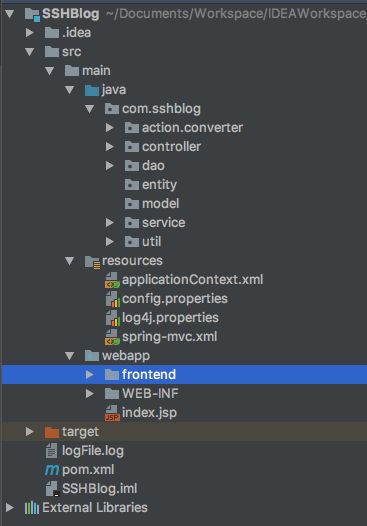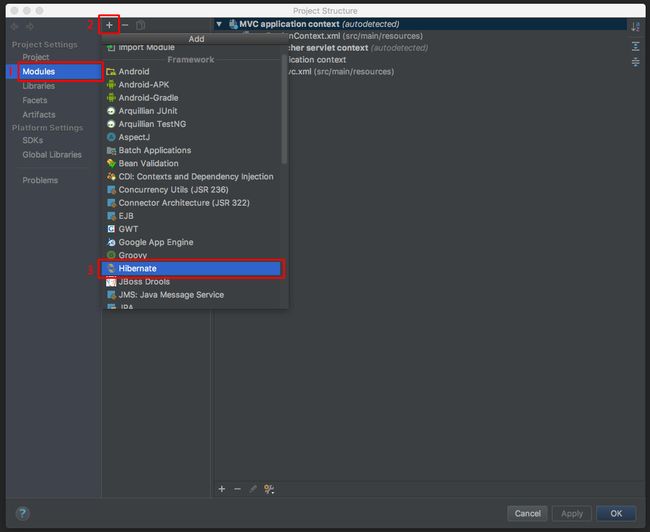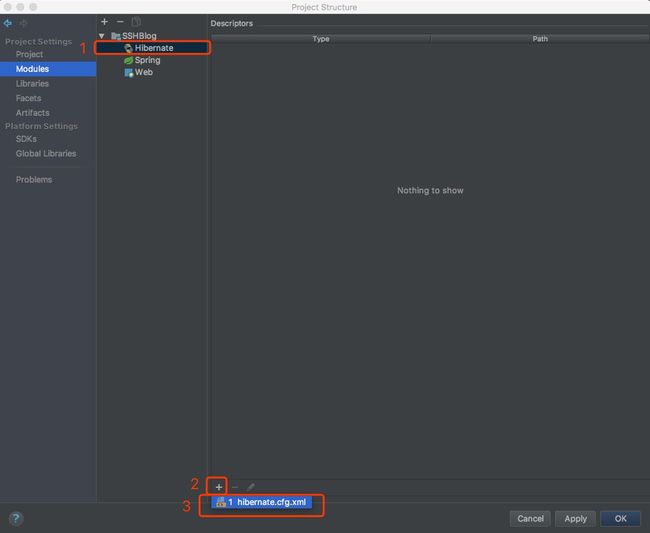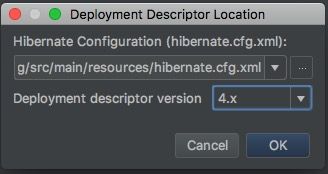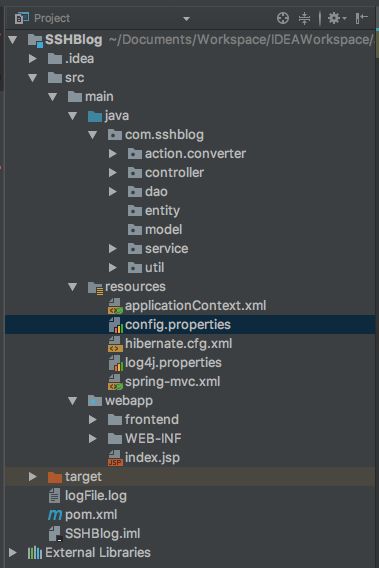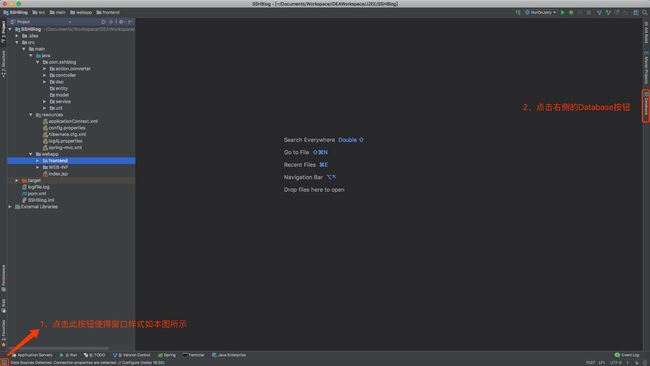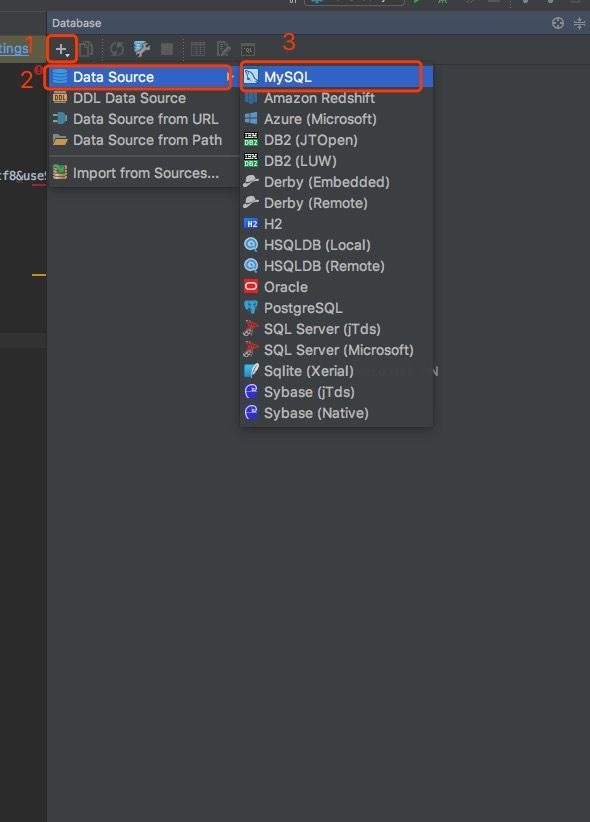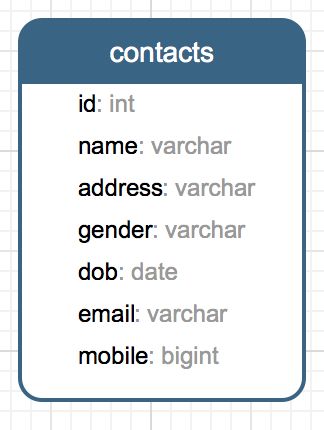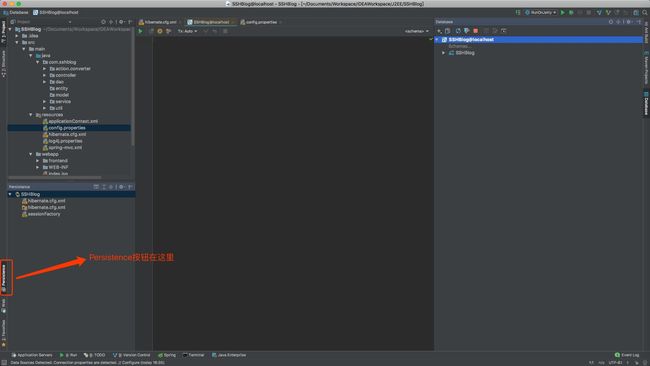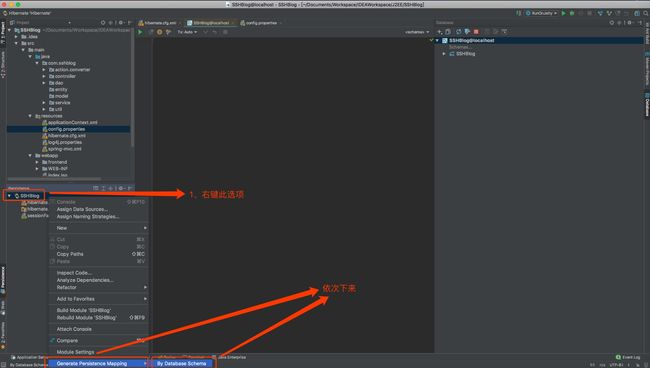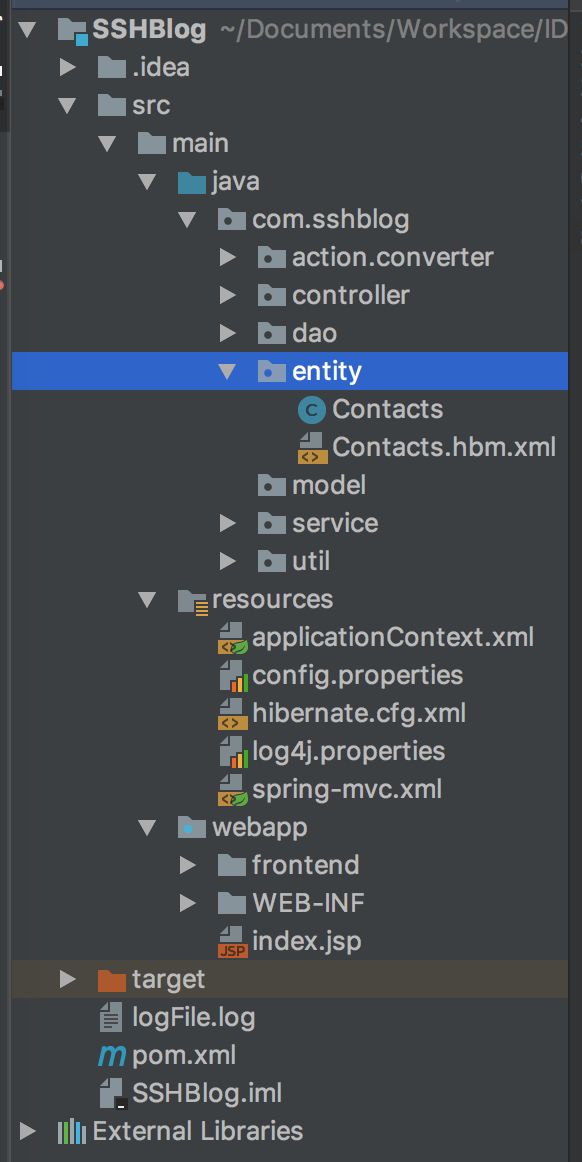IntelliJ IDEA下自动生成Hibernate映射文件以及实体类
1、构建项目并添加项目结构配置以及配置初始参数
1.1、如图将基本的架子搭建好
1.2、点击File,弹出的菜单中点击Project Structure;
1.3、点击左侧的Modules,再点击“+”号,再在弹出的菜单中选择Hibernate;
1.4、在这时,项目中多出了一个Hibernate,点击Hibernate,再点击“+”号,选择hibernate.hbm.xml;
1.5、弹出的窗口中选择Hibernate的版本,然后点击OK;
1.6、点击OK后在原来1.4步骤的窗口中的Apply按妞应用到项目;
1.7、这时项目架子中多出了一个名为hibernate.hbm.xml的配置文件;
1.8、在hibernate.hbm.xml中配置如下配置;
-
xml version=‘1.0’ encoding=‘utf-8’?>
-
-
“-//Hibernate/Hibernate Configuration DTD//EN”
-
“http://www.hibernate.org/dtd/hibernate-configuration-3.0.dtd”>
-
<hibernate-configuration>
-
<session-factory>
-
-
<property name=“connection.url”>jdbc:mysql://localhost:3306/SSHBlog?useUnicode=true&characterEncoding=utf8&useSSL=true&zeroDateTimeBehavior=convertToNull
property>
-
-
<property name=“connection.driver_class”>com.mysql.jdbc.Driver
property>
-
-
<property name=“connection.username”>root
property>
-
-
<property name=“connection.password”>
property>
-
-
-
update –>
-
session-factory>
-
hibernate-configuration>
1.9、第一步配置完毕。
2、配置数据库
2.1、点击左下角按钮,使窗口样式如图所示;
2.2、选择数据库;
2.4、配置数据库后测试连接是否成功,若成功后点击确定;
2.5、数据库如下;
3、生成Hibernate的实体类以及配置文件
3.1、点击窗口中的Persistence;
3.2、在Persistence中右键项目,然后点击Generate Persistence Mapping,选择By Database Schema;
3.3、选择数据源,配置实体类包,选择要生成的实体类(其中日期类型的只能手动修改为java.util.Date),然后点击OK;
3.4、等待一段时间之后,发现项目中的实体类以及配置文件已经自动生成。
3.5、生成的实体类以及配置文件如下所示;
实体类:Contacts.java
-
package com.sshblog.entity;
-
-
import com.fasterxml.jackson.annotation.JsonIgnoreProperties;
-
-
import javax.persistence.*;
-
import java.util.Date;
-
-
@Entity
-
@Table(name =
“contacts”)
-
@JsonIgnoreProperties(value = {
“hibernateLazyInitializer”,
“handler”,
“operations”,
“roles”,
“menus”})
-
public
class Contacts {
-
private
int id;
-
private String name;
-
private String address;
-
private String gender;
-
private Date dob;
-
private String email;
-
private Long mobile;
-
-
@Id
-
@Column(name =
“id”)
-
public int getId() {
-
return id;
-
}
-
-
public void setId(int id) {
-
this.id = id;
-
}
-
-
@Basic
-
@Column(name =
“name”)
-
public String getName() {
-
return name;
-
}
-
-
public void setName(String name) {
-
this.name = name;
-
}
-
-
@Basic
-
@Column(name =
“address”)
-
public String getAddress() {
-
return address;
-
}
-
-
public void setAddress(String address) {
-
this.address = address;
-
}
-
-
@Basic
-
@Column(name =
“gender”)
-
public String getGender() {
-
return gender;
-
}
-
-
public void setGender(String gender) {
-
this.gender = gender;
-
}
-
-
@Basic
-
@Column(name =
“dob”)
-
public Date getDob() {
-
return dob;
-
}
-
-
public void setDob(Date dob) {
-
this.dob = dob;
-
}
-
-
@Basic
-
@Column(name =
“email”)
-
public String getEmail() {
-
return email;
-
}
-
-
public void setEmail(String email) {
-
this.email = email;
-
}
-
-
@Basic
-
@Column(name =
“mobile”)
-
public Long getMobile() {
-
return mobile;
-
}
-
-
public void setMobile(Long mobile) {
-
this.mobile = mobile;
-
}
-
-
@Override
-
public boolean equals(Object o) {
-
if (
this == o)
return
true;
-
if (o ==
null || getClass() != o.getClass())
return
false;
-
-
Contacts contacts = (Contacts) o;
-
-
if (id != contacts.id)
return
false;
-
if (name !=
null ? !name.equals(contacts.name) : contacts.name !=
null)
return
false;
-
if (address !=
null ? !address.equals(contacts.address) : contacts.address !=
null)
return
false;
-
if (gender !=
null ? !gender.equals(contacts.gender) : contacts.gender !=
null)
return
false;
-
if (dob !=
null ? !dob.equals(contacts.dob) : contacts.dob !=
null)
return
false;
-
if (email !=
null ? !email.equals(contacts.email) : contacts.email !=
null)
return
false;
-
if (mobile !=
null ? !mobile.equals(contacts.mobile) : contacts.mobile !=
null)
return
false;
-
-
return
true;
-
}
-
-
@Override
-
public int hashCode() {
-
int result = id;
-
result =
31 * result + (name !=
null ? name.hashCode() :
0);
-
result =
31 * result + (address !=
null ? address.hashCode() :
0);
-
result =
31 * result + (gender !=
null ? gender.hashCode() :
0);
-
result =
31 * result + (dob !=
null ? dob.hashCode() :
0);
-
result =
31 * result + (email !=
null ? email.hashCode() :
0);
-
result =
31 * result + (mobile !=
null ? mobile.hashCode() :
0);
-
return result;
-
}
-
}
配置文件:Contacts.hbm.xml
-
xml version=‘1.0’ encoding=‘utf-8’?>
-
-
“-//Hibernate/Hibernate Mapping DTD 3.0//EN”
-
“http://www.hibernate.org/dtd/hibernate-mapping-3.0.dtd”>
-
<hibernate-mapping>
-
-
<class name=“com.sshblog.entity.Contacts” table=“contacts” schema=“SSHBlog”>
-
<id name=“id” column=“id”/>
-
<property name=“name” column=“name”/>
-
<property name=“address” column=“address”/>
-
<property name=“gender” column=“gender”/>
-
<property name=“dob” column=“dob”/>
-
<property name=“email” column=“email”/>
-
<property name=“mobile” column=“mobile”/>
-
class>
-
hibernate-mapping>
4、使用IntelliJ IDEA生成实体类的好处
使用IntelliJ IDEA的Hibernate生成实体类的好处是方便编码,提升编码效率;
相比较Eclipse而言,IntelliJ IDEA自带Hibernate生成的机制,而Eclipse则需要下载插件。
